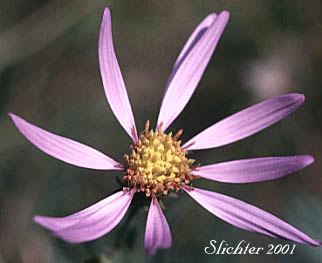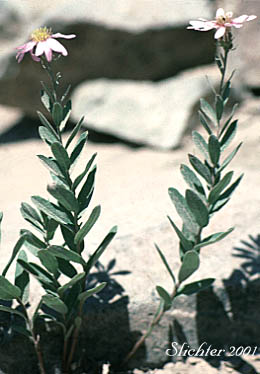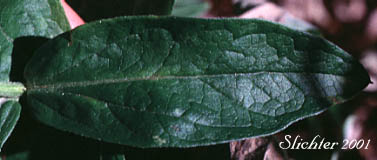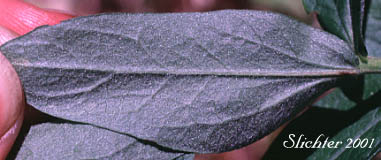Cascade Aster
Eucephalus ledophyllus var. ledophyllus
Synonyms: Aster ledophyllus, Aster ledophyllus var. covillei, Aster ledophyllus var. ledophyllus, Eucephalus ledophyllus var. covillei, Eucephalus ledophyllus var. ledophyllus


 Photo
at right of cascade aster from Sunrise on the northeast corner of Mt. Rainier
National Park..........August 23, 1996.
Photo
at right of cascade aster from Sunrise on the northeast corner of Mt. Rainier
National Park..........August 23, 1996.
Cascade aster is a pretty perennial wildflower with erect stems from 30-60 cm high. The upper stems are noticeably leafy while those of the lower stems are much reduced and scalelike. The upper leaves are largely uniform in size and shape and may be lanceolate or broadly elliptical in shape. The margins are generally entire with the bases sessile. The leaves vary from 3-7 cm long and 5-20 mm wide with a glabrous or slightly hairy upper surface and the lower surface covered with a fair accumulation of dense gray and cotton-like hairs.
The inflorescence consists of one to several (usual) flower heads which measure from 2.5-4 cm wide. If several to many flowers are present, the inflorescence is a corymb or raceme. The 6-20 pink to purplish rays surround a small, yellowish central disk. The rays vary in length from 12-20 mm long. The involucre is 7-11 mm high with 4-5 rows of narrow and sharp-pointed bracts. The midvein of each bract is evident or may be slightly keeled and each bracts is greenish above or may have purplish edges. The bracts may be finely glandular.
The relatively low number of wide rays, the lack of large leaves on the lower stems, and the fat, ovate leaves with gray-haired ventral surfaces are keys to identifying this species.
Cascade aster is a wildflower of open forests and meadows below timberline. It is more common in drier conditions than some other meadow asters which need more moisture.
Aster ledophyllus is found in the Cascade Mts. from northern Washington to southern Oregon.
In the Columbia River gorge, it may be found between the elevations of 3800'-4400' from Silver Star Mt. to Indian Springs.


